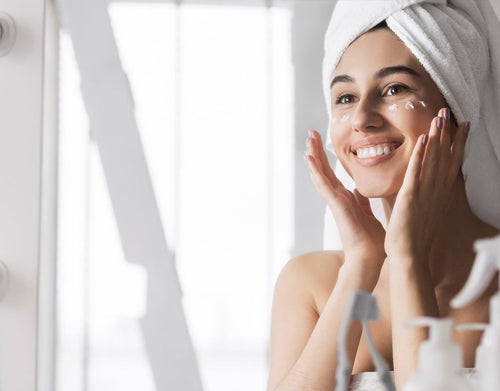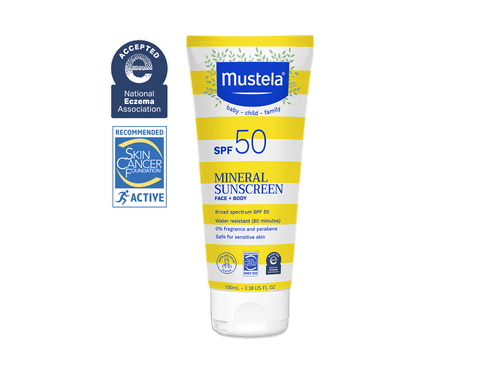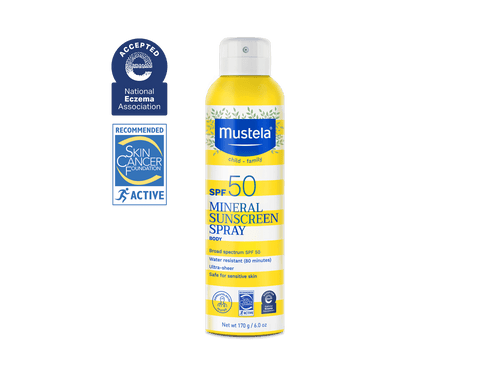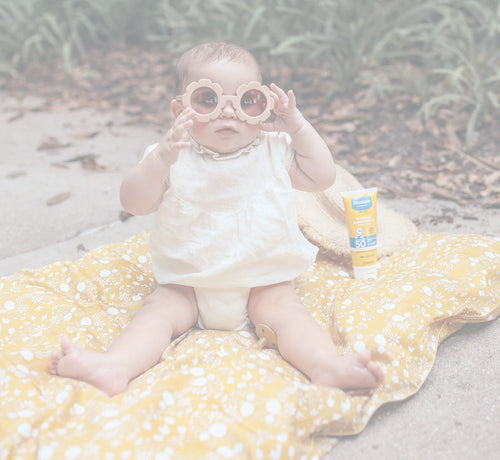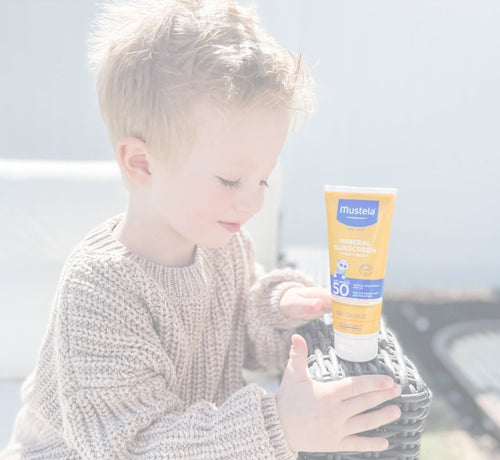You know the drill: Wear daily facial sunscreen to keep your skin healthy and vibrant! But when it comes to how much sunscreen to use on your face, how can you know you’re using the right amount? That’s exactly what we’ll discuss in this article.
In addition to how much sunscreen to use, we’ll also cover when to apply face sunscreen and how to choose one that effectively wards off the sun’s rays and is safe for your and your family’s skin, too.
Don’t just slap some sunscreen on and hope for the best. Keep reading to feel confident about your skin care!
Key Takeaways
-
Takeaway #1: You need between ¼ and ½ teaspoon of sunscreen for your face. Another way to measure it? You need a dot the size of a nickel.
-
Takeaway #2: Make sunscreen application a vital part of your morning routine. Wash your face, put on lotions, then apply sunscreen, and finish with makeup.
-
Takeaway #3: Broad-spectrum sunscreen, high in SPF and PA+, will keep you and your skin the safest and healthiest.
How Much Sunscreen To Use On Your Face

The American Academy of Dermatology recommends applying “enough sunscreen to cover all skin that clothing will not cover.” They go on to note that, for most adults, this will be around one ounce of sunscreen for one application on the whole body.
But what about just your face?
In general, you’ll need between ¼ to ½ of a teaspoon for your face (and a bit less for your child’s face). Pull out a measuring spoon to get an idea of how much this is. Or, think of a dollop about the size of a nickel.
That said, the exact amount depends on how big your face is and whether or not you’re also applying sunscreen to your exposed decolletage. If you need more than ½ a teaspoon to provide adequate coverage, go for it.
For sunscreens that can’t be measured in dollops (such as stick sunscreens), ensure that you’re covering your whole face — no skin left behind! — and rubbing it in well. You’ll learn to get a feel for whether or not you’ve applied enough for your whole face.

Our fragrance-free SPF 50 Mineral Sunscreen Stick comes in a conveniently small size, making it travel-friendly and ideal for both face and body. This is a great option for protecting wiggly kids’s faces from the sun!
Regardless of the type of sunscreen you use, the quantity doesn’t matter much if you aren’t applying it evenly over your face. For lotion sunscreen, put a dollop in your hand and then dot it over your face before gently rubbing it in.
Keep your whole face in mind, even the easily-forgotten areas, like your hairline, the tops of your ears, and the skin just behind your ears.
Sunscreen And Your Baby
Because your baby’s skin is sensitive, try to minimize the amount of sunscreen you use on them. Some sunscreen products can irritate their delicate skin, or even cause a rash.
Babies don’t have all of their melanin, the natural pigment that helps protect us from the sun’s rays, so they’re more susceptible to sunburn than we are. In fact, putting sunscreen on them can make you think they’re protected when they’re not.
Melanin reaches its permanent level at six months old, so try to wait until that half-year mark to begin using sunscreen. Dress your baby in sun protective clothing instead. Or keep them in the shade.
But if you need to use sunscreen, choose a physical one (with titanium dioxide or zinc oxide), like one of our SPF 50 Mineral Sunscreen choices. Use only a small amount and remember to reapply it after swimming, sweating, or just every two hours.
When To Apply Face Sunscreen

Now, we turn our attention to when to apply facial sunscreen. Every day? When you hit the beach? Twice a day? Before or after makeup? Let’s take a look.
First things first, apply facial sunscreen every day to your whole family! You’re exposed to the sun daily even if you aren’t spending hours outside. Think about the time you spend running errands, watching your kids’ sports practice, and the like.
Even on cloudy days, it’s a good idea to wear sunscreen. The American Academy of Dermatology notes that up to 80% of the sun’s rays can make their way through the clouds and hit your skin.
In addition, UVA rays are capable of going through glass. So, even on the days you spend inside, you can still be exposed to UVA rays if you’re near a window.
And remember that the sun still shines in the wintertime! We recommend applying sunscreen on yourself and your kids every day and all year long.
As far as what time of day to apply facial sunscreen, we recommend making it part of your family’s morning routine. That way, you’re good to go for the day, and you’ll be more likely to make it a habit.
Sunscreen Application Routine
Apply sunscreen as part of your normal skincare routine.
- Wash your face first if this is how you start your morning skincare session.
- Next, apply whatever moisturizers and lotions you like to use. Let them totally absorb into your skin before putting on sunscreen; they’ll help the sunscreen form a more solid barrier between your skin and the sun.
- Then put on sunscreen. Try dotting it on different parts of your face: your forehead, cheeks, chin, nose, and don’t forget your neck! Get those forgotten edge places on your face too: your hairline, the tops of and behind your ears, as well as your jawline.
- Finally, put on whatever makeup you want for the day.
- Don’t forget to reapply sunscreen as needed. For days outside enjoying the sun, reapply every two hours and more often if you’re sweating or in and out of the water.
How To Choose A Face Sunscreen

Now that we’ve discussed how much sunscreen to use on your face and when to apply it, let’s wrap up by discussing how to choose a facial sunscreen. We’ll mention what to look for in a sunscreen that is safe and gentle on even the most sensitive skin.
Broad-Spectrum Protection
We already mentioned UVA rays (which can go through glass), but the sun also produces UVB and UVC rays. The UVC rays don’t make it to the surface of the earth, but we do need protection from UVA and UVB rays.
That’s where the term “broad-spectrum” comes into play. A broad-spectrum sunscreen wards off both UVA and UVB rays, not just one or the other.
The good news is that it’s easy to tell if your sunscreen offers this type of protection since “broad-spectrum” will typically be listed on the sunscreen bottle.
What exactly do UVA and UVB rays do to our skin?
First, it’s important to note they aren’t the same. UVA rays make up about 95% of the light that makes it to the earth’s surface. They have long wavelengths and can penetrate deep into our skin, damaging collagen and elastin and contributing to premature aging.
UVB rays, on the other hand, make up 5% of the light that hits the earth. It has shorter wavelengths but is high energy and easily damages the top layers of your skin, causing sunburn. Both UVA and UVB rays can lead to skin cancer, so broad-spectrum protection is vital.
SPF
In addition to opting for broad-spectrum protection, choose the appropriate SPF (sun protection factor). This measures the sunscreen’s protection against UVB rays and is listed in numbers such as 15, 25, 30, and 50 and appears clearly on the sunscreen label.
The Skin Cancer Foundation offers two seals for sunscreen: The Daily Use seal and the Active Use seal. The sunscreens they recommend for daily use offer SPF 15 or higher. This is appropriate for sun exposure you might have during everyday activities, like walking to the car.
Meanwhile, the Active Use seal is for sunscreens with SPF 30 or higher. These are recommended for longer sun exposure during outdoor activities and fun in the sun.
That said, the American Academy of Dermatology recommends using a sunscreen with SPF 30 or higher. Rest assured that all Mustela sunscreens are either SPF 30 or SPF 50.
PA+
Although less familiar than SPF, another sunscreen rating system called PA+ (Protection Grade of UVA) is used to indicate the level of protection the sunscreen has against UVA rays. The higher the level of UVA ray protection, the more plus signs (+) you’ll find.
Ideally, you want to find a sunscreen that has both a higher SPF and a higher PA+.

When choosing sunscreen for your face, we also recommend one that provides mineral protection. If you aren’t sure about the difference between mineral and chemical sunscreen, here’s the short rundown.
The difference is in the active ingredients, which are the ingredients in a sunscreen that do the heavy lifting of blocking the sun’s rays.
Chemical sunscreens use chemical ingredients (such as oxybenzone, avobenzone, octinoxate, or homosalate) to absorb and dissipate the rays. Mineral sunscreens, on the other hand, use zinc oxide or titanium dioxide to provide a physical barrier and deflect the rays off of your skin.
We recommend mineral sunscreen since it uses natural ingredients instead of questionable chemical ingredients. In fact, zinc oxide, one of the minerals used in mineral sunscreen, is so skin-healthy that it’s used in many diaper creams!
Meanwhile, chemical sunscreens protect your skin from the sun, but at the same time, they can be irritating to your skin at best and harmful at worst.
Your skin absorbs those chemical ingredients, which can be bad news for those with sensitive skin. Plus, small amounts of chemicals can make their way into your blood and other body fluids, such as breast milk.
You can understand why we think it’s better to steer clear of chemical sunscreen altogether.
Natural Ingredients
Active ingredients save your skin from the sun. Inactive ingredients contribute to your sunscreen’s texture or scent. Choose gentle, natural ingredients all the way around.
We’ve already mentioned how to go the natural route with active ingredients. What about inactive ingredients?
Look for plant-based ingredients that come straight from the earth, such as coconut oil, macadamia oil, shea butter, avocado oil, sunflower seed oil, aloe vera, calendula, chamomile flower extract, and jojoba.
For example, our SPF 50 Mineral Sunscreen Lotion is made with 93% ingredients of natural origin per ISO 16128 standard, including coconut oil, macadamia oil, and vitamin E to hydrate your skin. The lightweight, sheer texture blends easily and does not leave a white cast on the skin.
Gentle enough to use on babies and compliant with Hawaii’s sunscreen ingredient requirement, this sunscreen is a win for everyone — your whole family and the ocean, too!
Busting Myths About Sunscreen
A lot of misinformation is floating around about sunscreen and its safety. Here we try to dispel some of these myths.
1) Sunscreen Does NOT Cause Cancer
There is no evidence to support this statement. While studies were done where individuals who used sunscreen had a higher risk of skin cancer, that was not the full story.
The key missing piece of the story was that these individuals were traveling to sunnier climates and sunbathing. So the correlation was between the amount of sun exposure, not the amount of sunscreen.
2) Nanoparticles Of Titanium Dioxide And Zinc Oxide Are NOT Harmful
Remember when physical sunscreens — the ones that contain titanium dioxide and zinc oxide — made your skin white? (Think about those stereotypical beach movies where the lifeguard’s nose was white!) The reason was because those sunscreens were made of large particles.
Now, most physical sunscreens are made by micronizing, or reducing, those large particles into nanoparticles, which makes them much easier to blend and dissolve into your skin.
But accusations that those nanoparticles are so small that they penetrate into the bloodstream are false.
3) Darker Skin Means No Need For Sunscreen
While darker skin tones are at a much lower risk of developing skin cancer, they are still subject to the wrinkling, premature aging effects, and damage to collagen and elastin that too much UVB ray exposure can cause.
Other Sun Protection Methods
Sunscreen is your number one line of defense for preventing sunburn (as well as sun damage, sun poisoning, and skin cancer), but you may want to add another layer or two of protection when you can.
Shade
Staying out of the sun is a smart way to avoid sunburn. Seek out shade from trees, umbrellas, and hats, or stay indoors when the sun is at its peak. In North America that means between 10 a.m. and 4 p.m.. A big part of the day!
While it would be tricky to stay shaded for all of that window of time (and probably make you and your kids stir crazy), choosing some of that timespan to stay out of the sun is a good idea.
Don’t trade sunscreen for the shade, though. Use them together. UV rays are sneaky, and they can find you by reflecting off of other surfaces.
Clothing
Some clothing has built-in sun protection. The UV protection factor (UPF) is often labeled somewhere on them. Just like sunscreen, the UPF is on a scale from 15 to 50+. The higher the number, the more protection the clothing offers.
The tightness of the fabric weave determines how sun-protective a piece of clothing can be. The tighter the weave, the stronger the protection.
In addition, some specially designed laundry detergents can coat your clothing with microscopic white crystals that reduce sun exposure too. The crystals tend to stay in the fabric for about 20 washings before you need to reapply.
Hats
Help protect those harder-to-reach spots, like the tops of your ears, the back of your neck, and your scalp, by wearing a hat. A wide-brimmed hat — with a 2-3 inch brim all around it — is a great choice, especially if its underside is a dark color, which can minimize sun reflection.
Shade caps look like baseball hats with draping fabric down their sides and back. Like a wide-brimmed hat, shade caps protect those spots on your head that often don’t get enough sunscreen. You can make a shade cap by wearing a bandana under a baseball hat.
UV Sunglasses
The skin around your eyes is delicate and sometimes it’s too hard to apply sunscreen to it, so sunglasses can be a useful addition to your sun gear. Some glasses can block just about 99% of harmful UVA and UVB rays.
Look for sunglasses with an ANSI (American National Standards Institute) approval label on them.
The Perfect Amount Of Sunscreen For Your Face

Now that you’ve read this article, there’s no need to second-guess how much sunscreen to use on your face every time you slather it on.
The perfect amount of sunscreen is whatever will adequately cover all of your skin, providing the protection you need. While that can vary a bit from person to person, aim for the typical recommendation of ¼ to ½ of a teaspoon.
If you use a stick sunscreen, such as our SPF 50 Mineral Sunscreen Stick, apply it to all areas of your and your kids’ faces and rub it in well. If you prefer a lotion sunscreen, consider our SPF 50 Mineral Sunscreen Lotion.
And if you find it more convenient to use a spray sunscreen (some kids tolerate putting on a spray version much better than a lotion or stick), try our SPF 50 Mineral Sunscreen Spray. Shake it first, then hold it 4-6 inches from the skin and spray.
While you can’t spray directly onto the face, you can spray into your hands. Then rub them together and apply to your or your child’s face.
With the right amount of skin-safe mineral sunscreen and good application techniques, you can rest easy knowing that your family’s skin is well cared for. Time to take on the day!
Frequently Asked Questions
How Much Sunscreen Should You Put On Your Face And Neck Combined?
According to many dermatologists, an ounce of sunscreen is sufficient to cover your whole body. (Think of filling a shot glass — that’s an ounce!) So how much less do you put on just your face and neck?
Your face and neck account for about 4% of your whole body, so you need .04 ounces of sunscreen to cover them. What does that look like? About the size of a quarter.
What Is The Two Finger Rule When It Comes To Sunscreen?
You want to apply the right amount of sunscreen to best protect your skin, but you don’t want it to feel thick and you don’t want to waste it. So, how much is just enough?
Many people adhere to the “two finger rule” when it comes to applying sunscreen. When you’re using the lotion variety, simply squeeze a line down the length of two of your fingers. This should be the right amount for each “zone” of your body. (Your face and neck are one zone.)
Do I Really Have To Wait 15 Minutes After Applying Sunscreen?
Yes, you really do! Your skin needs about 15 minutes to absorb the sunscreen to protect you from the sun. Try taking your sunscreen out of your bag and putting it somewhere visible near your front door. Then you’ll remember to put it on before going outside.



